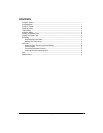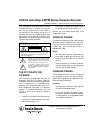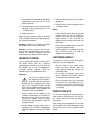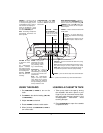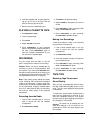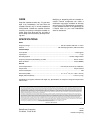
2
1. Press down on the tabs above the battery
compartment cover and pull the cover
down to remove it.
2. Place the batteries in the compartment as
indicated by the polarity symbols (+ and
–) marked inside.
3. Replace the cover.
When the sound becomes weak or distorted
or the cassette recorder stops operating prop-
erly, replace the batteries.
Warning:
Dispose of old batteries promptly
and properly. Do not burn or bury them.
Caution:
If you do not plan to use the cas-
sette recorder with batteries for several days,
remove the batteries. Batteries can leak
chemicals that can destroy electronic parts.
USING DC POWER
You can power the cassette recorder from a
12V power source (such as a vehicle’s
cigarette-lighter socket) using a 9V, 500 mA
DC adapter and a size M Adaptaplug™
connector (neither supplied). Both are
available at your local RadioShack store.
Cautions:
You must use a power source
that supplies 9V DC and deliv-
ers at least 500 mA. Its center
tip must be set to negative and its plug
must fit the cassette recorder’s
DC 9V
jack. Using an adapter that does not meet
these specifications could damage the
cassette recorder or the adapter.
• Always connect the DC adapter to the
cassette recorder before you connect it to
the power source. When you finish, dis-
connect the adapter from the power
source before you disconnect it from the
cassette recorder.
1. Set the adapter’s voltage switch to 9V, if
necessary, then connect the Adaptaplug
to the DC adapter’s cord so the tip reads
TIP–.
2. Insert the barrel plug into the recorder’s
DC 9V
jack.
3. Plug the other end of the adapter into the
12V power source.
Notes:
• If the cassette recorder does not operate
properly when you use DC power, be
sure the 12V source (such as a cigarette-
lighter socket) is clean and that the
adapter’s plug is pushed all the way into
the socket.
• Disconnect the adapter when you are not
using the cassette recorder.
• Internal batteries (if installed) automati-
cally disconnect when you plug the
adapter into the
DC 9V
jack.
LISTENING SAFELY
To protect your hearing, follow these guide-
lines when you use headphones.
• Set the volume to the lowest setting
before you begin listening. After you
begin listening, adjust the volume to a
comfortable level.
• Do not listen at extremely high volume
levels. Extended high-volume listening
can lead to permanent hearing loss.
• Once you set the volume, do not increase
it. Over time, your ears adapt to the vol-
ume level, so a volume level that does
not cause discomfort might still damage
your hearing.
TRAFFIC SAFETY
Do not wear headphones while operating a
motor vehicle or riding a bicycle. This can cre-
ate a traffic hazard and could be illegal in
some areas.
Even though some headphones let you hear
some outside sounds when listening at normal
volume levels, they still can present a traffic
hazard.
!



